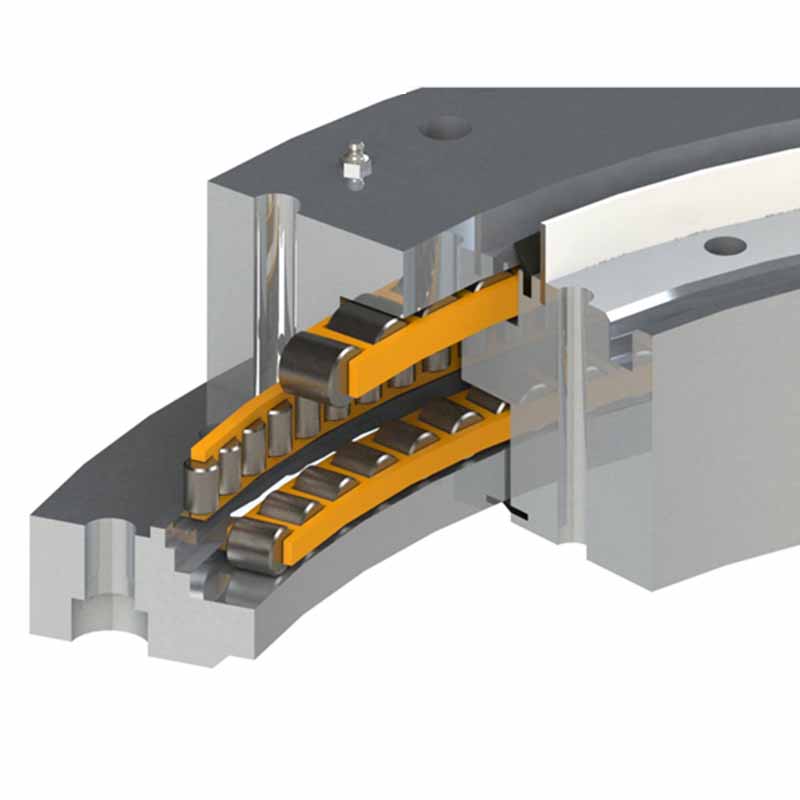Three-row roller slewing bearings are highly sophisticated engineering components designed to support heavy loads in applications requiring rotational movement. These bearings are distinguished by their three separate rows of rollers, which accommodate axial loads, radial loads, and tilting moments independently. This design allows for maximum load capacity in all directions, making them suitable for extremely demanding applications.
Three Row Roller Slewing Bearing
The three-row roller slewing bearing consists of an inner ring, an outer ring, three rows of rollers
Read More Get A QuoteFeatures of Three-Row Roller Slewing Bearings
Three Rows of Rollers: Each row is typically designed to bear different types of loads: one row for axial loads in one direction, another row for axial loads in the opposite direction, and the middle row for radial loads. This setup allows for excellent load handling and stability.
Separate Raceways: To accommodate the three rows of rollers, these bearings have three separate raceways in both the inner and outer rings. This design ensures that each row of rollers can function optimally and independently.
High Load Capacity: The configuration allows these bearings to support larger loads compared to single or double row configurations. They can handle heavy axial, radial, and moment loads simultaneously.
Robust Structure: Made from high-quality, hardened steel, these bearings are built to withstand harsh conditions and heavy wear.
Integrated Gearing: Like other slewing bearings, three-row roller slewing bearings can be equipped with internal or external gears, or be gearless, depending on the application requirements.
Advanced Sealing: These bearings are equipped with high-performance seals to prevent the ingress of contaminants and to retain lubrication, which is crucial for maintaining longevity and performance in dirty or harsh environments.
Advantages of Three-Row Roller Slewing Bearings
Maximum Load Capacity: The three-row design provides the highest load capacity among slewing bearings, suitable for the heaviest applications.
High Rigidity and Stability: The separation of load directions enhances the bearing's overall stability and rigidity, which is critical for applications involving significant tilting moments.
Compact Design: Despite their high load capacity, these bearings are designed to be as compact as possible, saving valuable space in machine design.
Versatility in Applications: Can be customized with various diameters, roller types, gear configurations, and materials to suit specific operational needs.
Durability: Designed to endure tough operating conditions, providing reliable performance over long periods.
Common Applications of Three-Row Roller Slewing Bearings
Heavy-Duty Cranes: Ideal for tower cranes, mobile cranes, and ship cranes where high load capacity and rotational accuracy are required.
Wind Turbines: Used in large wind turbines, particularly in the yaw and pitch mechanisms that adjust the blade and nacelle positions.
Large Excavators and Tunnel Boring Machines: Essential in the rotational joints of these machines, handling the high loads and complex movements involved.
Marine Applications: Used in shipboard cranes, offshore platforms, and large marine propulsion systems.
Rotary Tables and Heavy-Duty Turntables: Common in large manufacturing and assembly applications, where they support heavy loads while providing precise rotation.
How to slect Three-Row Roller Slewing Bearings
Accurate Load Analysis: It is crucial to perform a detailed analysis of the expected loads (axial, radial, and moment) to ensure the bearing’s capacity aligns with the application’s demands.
Environmental Conditions: The operating environment’s impact on material selection, sealing, and lubrication strategies must be carefully considered.
Maintenance and Accessibility: Given their critical role and operational conditions, ease of maintenance and the ability to inspect and replace components are important considerations.
Quality and Certification: Choosing bearings from reputable manufacturers with appropriate certifications ensures reliability and compliance with industry standards.
Customization: Due to the variety of applications, customization in terms of size, materials, gearing options, and sealing systems is often necessary.




